In some quarters, flip-flops are maligned as everything that is wrong with modern menswear; comfort obsessed, overly casual, and disposable. But, since 2006, flip-flop sales have eclipsed even sneaker sales in North America. So, whether you consider them tops or flops, flip flops have certainly flipped the script when it comes to casual footwear, but why did men wear them in the first place?
Today, we talk about the history of flip-flops, and the precursor, the sandal. We’ll follow their progress into the 20th Century and the explosion of popularity flip-flops have experienced since the early 2000s. We’ll determine why men started wearing flip-flops and determine their place within the classic style, because believe it or not, they do have a place.
History of Flip Flops
Let’s first trace the origins and development of the flip-flop through history. Sandals, the proto-flip-flops, are one of the oldest shoe types. A cachet of woven fiber sandals found in Oregon’s Fort Rock Cave could be around 10,000 years old.
Some truly fantastic sandals could be found in Ancient Egypt. Most ancient Egyptians went barefoot, and only wealthy and important figures wore sandals. Accordingly, some were highly decorated, like those that came from the tomb of the famous pharaoh, King Tut.
![Fiber Sandals A pair of woven fiber sandals found in Oregon's Fort Rock Cave [Image Credit: The Oregon Encyclopedia]](https://www.gentlemansgazette.com/wp-content/uploads/2022/07/fiber-sandals-1030x579.jpg)
![Sandals King Tut's pair of ornate sandals [Image Credit: Oregon Museum of Science and Industry]](https://www.gentlemansgazette.com/wp-content/uploads/2022/07/sandals-1030x578.jpg)
When comparing construction, you’ll see that the toe post design hasn’t changed much between this example, which is about 3,000 years old, and modern flip flops.
Of course, sandal design could vary greatly depending on location and function. Just look at the statutory fragment from the 1st or 2nd Century A.D. offers us a glimpse of a Roman military sandal and an illustration of a Japanese samurai donning a pair of tied-on waraji.
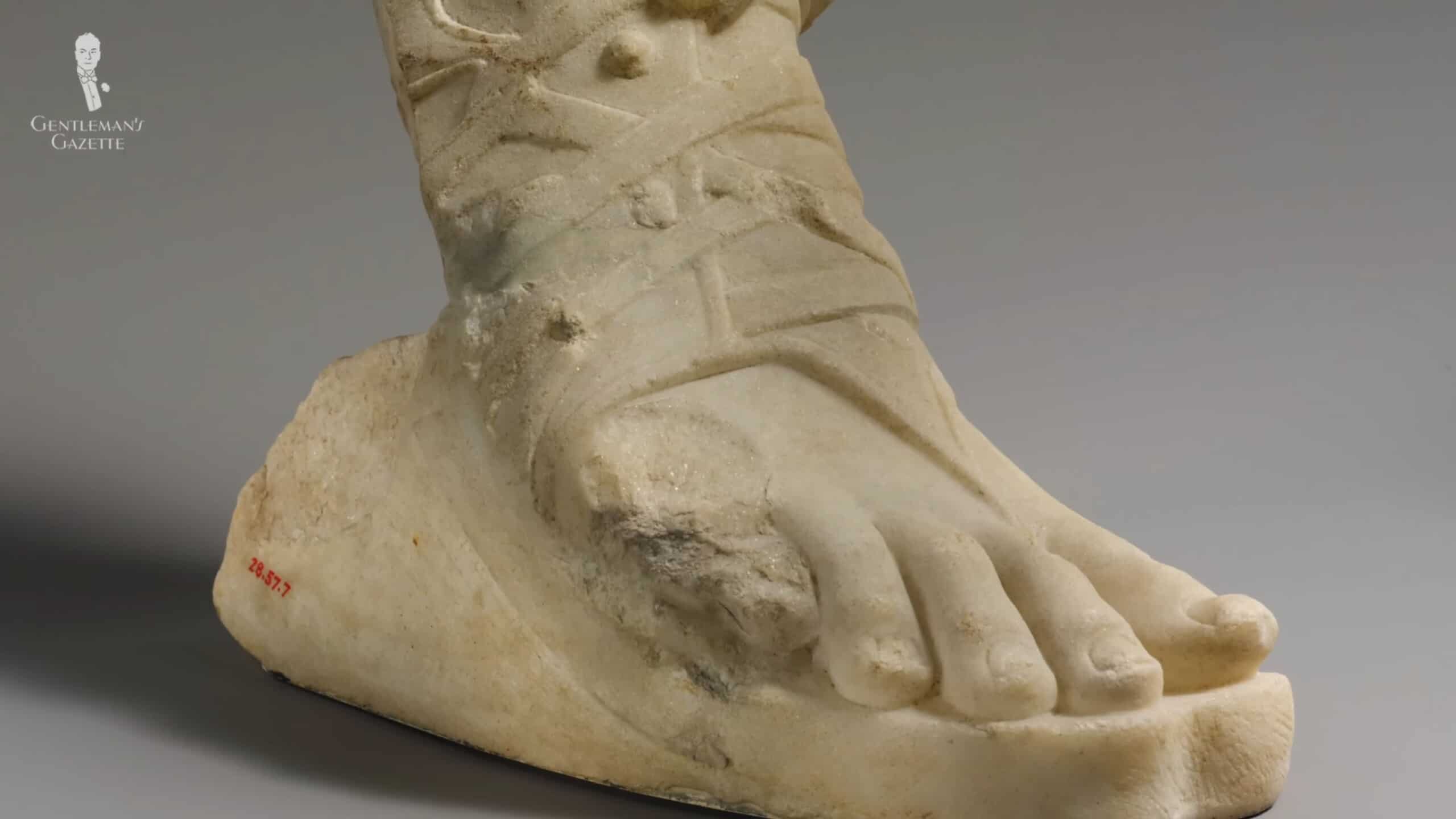

Sandals were worn in the West well into the early modern period, often as an inexpensive day shoe for utilitarian functions or for travel. They are even mentioned in Shakespeare. “How should I, your true love, know from another one? By his cockle head and staff and his sandal shoon.”
Raphael will teach you more about sandals and why they aren’t in favor for classic style in a separate guide, but for our purposes today, let’s skip ahead to the middle of the 20th Century.
Sandals for Men: Should You Wear Them? Summer Footwear Do’s and Don’ts
Mid 20th Century
According to popular tradition, allied servicemen stationed in Japan after World War II adopted the tradition of wearing zōri as house shoes. Zōri are a type of slip-on Japanese sandal, which evolved from the aforementioned waraji. Wartime constraints near the end of World War II necessitated that Japanese zōri be made out of rubber and, upon the war’s conclusion, these rubber zōri could be made cheaply and sold across the globe.
They soon became associated with comfort and ease and were solely adopted by the burgeoning surf culture in North America, Australia, and New Zealand. In most Anglophonic nations, these shoes were widely referred to as “thongs.”
![Zori Japanese slip-on sandals called Zōri [Image Credit: akaitori]](https://www.gentlemansgazette.com/wp-content/uploads/2022/07/zori-1030x573.jpg)
“Thong” is a term for a leather strap, like the strap used on these shoes. Although, the name “jandals” were also sometimes used as a portmanteau of “Japanese sandals.”
The term “flip-flops” is an onomatopoeia of the sound they make when they are worn, and it became commonplace in the late 1960s in North America.
In 1962, the Brazilian company Havaianas started mass producing these rubber sandals that resembled zōri. With distinctive blue and white coloring, their name comes from the Portuguese word for “Hawaiians” because similar style sandals were often a common sight on the beaches of Hawaii, which does have a large population of Japanese immigrants.
![Havs A pair of the popular Brazilian slippers, Havaianas [Image Credit: Angelvisarra.Xyz]](https://www.gentlemansgazette.com/wp-content/uploads/2022/07/havs-1030x539.jpg)
In Brazil, Havaianas were associated with the working classes and, within a few years, were one of the nation’s most popular shoe styles. In 1966, the owners of Havaianas, Alpargatas, patented their design. And for all intents and purposes, the modern flip-flop was fully born.
For most of the 1950s and early 1960s, a more traditional style of shoe had remained popular with beach goers, such as boat shoes, the canvas Keds in an advertisement from 1962, and espadrilles like those worn by Alain Delon in Plein Soleil, an early film adaptation of The Talented Mr. Ripley in 1999, which made a style review about.
As the 1960s wore on, flip-flops became synonymous with beach life; beloved by surfers, appearing poolside, and even earning a mention in the 1964 Beach Boys song All Summer Long.
![Canvas Shoes A 1962 Keds canvas shoes ad [Image Credit: VintagePaperHeaven]](https://www.gentlemansgazette.com/wp-content/uploads/2022/07/canvas-shoes-1030x567.jpg)
The popularity of flip-flops and similar casual shoes continued to grow. In the early 1970s, entrepreneur Jay Longley began hand-making flip-flops out of rubber and leather out of his Laguna Beach, California home; averaging about 15 pairs a day.
In 1974, he founded Rainbow Sandals in San Clemente, California. It could turn on about 1,200 a day from its production facility, and that same facility is still up and running today.
Around the same time, University of California, Santa Barbara students Doug Otto and Karl Lopker were selling their own flip-flops, which they dubbed “Deckers” because the layer construction of the soles resembled wooden decks.
Late 20th Century
In 1984, Reef Sandals was founded by Argentinian brothers Fernando and Santiago Aguerre after they moved to La Jolla, California. Reef products were originally manufactured in Brazil like Havaianas, and this connection was emphasized in Reef advertising.
![Sandals Teva Teva sandals with Velcro straps [Image Credit: Gevshop]](https://www.gentlemansgazette.com/wp-content/uploads/2022/07/sandals-teva-1030x552.jpg)
Also, in 1984, Teva sandals were conceived, when Mark Thatcher, a Grand Canyon river guide, was distraught over how often his flip-flops would float away. He then used Velcro straps to affix them to his feet.
In the 1990s, flip-flops and other sport sandals grew in popularity – both at the beach and for other outdoor excursions like walking or hiking.
21st Century
After saturating the leisure market, flip-flop manufacturers undertook a conservative effort in the early 2000s to market their wares as perfectly acceptable everyday shoes. Children and young people were some of the first to accept this trend.
In 2005, lacrosse athletes from Northwestern University caused a minor “sandal scandal” in the United States when some players decided to wear flip-flops to a formal photograph with President George W. Bush. But, just a few years later in 2011, Barack Obama became the first sitting US President to appear in public wearing flip-flops at an ice cream parlor in Hawaii.
![Flipflops Celebrities Zac Efron and Ashton Kutcher wearing flip-flops [Image Credit: Left: Harper's Bazaar; Right: All4Manpris]](https://www.gentlemansgazette.com/wp-content/uploads/2022/07/flipflops-1030x571.jpg)
By this time, flip-flops had already become a common sight across the globe for about a decade; worn by everyday men as they ran errands or did chores, but also gracing the feet of the famous, including JC Chasez and Justin Timberlake of NSYNC, Leonardo DiCaprio, and Liam Hemsworth.
Flip-flops are now considered a mainstay in many menswear spheres. Several luxury brands have even entered the flip-flop market, including Gucci retailing at $320, Louis Vuitton at $350, and Giorgio Armani at $550. That’s a long way for flip-flops to go from the favelas of Brazil to the high-fashion runway. But, those are the only costs of flip-flops.
![Trash Flipflops make up a huge portion of landfills [Image Credit: ATTN]](https://www.gentlemansgazette.com/wp-content/uploads/2022/07/trash-1030x577.jpg)
Due to their casual and feral nature, many flip-flops are treated as disposable products. Every year, about three billion flops are made and many promptly end up in the trash; constituting, in some regions, up to 25% of pollutants in the ocean.
Recognizing this sad reality, several sustainable flip-flop companies have been founded, including the Hawaiian-based brand OluKai in 2006.
Why Men Started Wearing Flip Flops
Now that we’ve traced the full history of the flip-flop – from beach-going bobble to high-fashion footwear – let’s identify the factors that led men to start wearing them. I’ve previously touched upon some of these topics in our “Why Did Men Stop Wearing Dress Shoes?” post, but for now, we’re sticking strictly to sandals and fixing firmly on flip-flops.
1. Holiday Culture
Following the Second World War, additional leisure time and reduced fuel costs made it easier than ever to take vacations and holiday time, especially to distant exotic locations with beaches as a favorite getaway location. Because modern holiday culture was still developing, there was not yet an established wardrobe, so vacationers would quickly learn to pick up local items that would suit the climate.
![Vacation Flipflops became a vacation staple wear especially at the beach [Image Credit: Love Exploring]](https://www.gentlemansgazette.com/wp-content/uploads/2022/07/VACATION-1030x573.jpg)
We love leather dress shoes, but even we have to admit they don’t mix well with beaches. Flip-flops being cheap, easy to fit, and ideal for hot climates were favored purchases. Because they’re easy to pack, these flip-flops were often taken home both for occasional use, but also as a souvenir of the trip. Oftentimes, these beach accessories could find themselves adopted into regular clothing rotation, especially when the wearers found themselves missing the seaside and the beach lifestyle.
2. Beach Culture
That laid-back, fun lifestyle first explored by beach culture soon became its own ethos in the popular psyche. Between Salt Life decals, Margaritaville restaurants, and the beach country musical subgenre, it was clear that people wanted to relax and enjoy a more laid-back, beach lifestyle, even when not at the beach.
![Laidback Laidback beach-inspired outfits with flipflops [Image Credit: The Telegraph]](https://www.gentlemansgazette.com/wp-content/uploads/2022/07/laidback-1030x578.jpg)
And one way to do that was to regularly wear flip-flops. This trend crashed headlong into the growing casualization of menswear, which we discussed in greater detail in another guide tackling the decline of classic menswear, and the result was an increasing willingness to accept flip-flops outside of pools and beachfronts.
The Role of Classic Menswear in Today’s World
3. Societal Casualization
As society became increasingly casual, workplaces followed; albeit much more slowly. Many of the new industries of the 90s and 2000s, primarily in the computer and digital arenas, were more willing to adapt to the desires of the workers to dress more casually in the workplace; forsaking suits and Oxfords for T-shirts and flip-flops.
![Workplace Flipflops became acceptable to be worn in workplaces [Image Credit: Inc. Magazine]](https://www.gentlemansgazette.com/wp-content/uploads/2022/07/workplace-1030x583.jpg)
Like flip-flops, these tech industries were nurtured under the sunny skies of California and that beach life attitude found its way into Silicon Valley boardrooms; helped along by more utilitarian capitalism that didn’t quite care how workers were dressed, just as long as they clocked in every day and did their work. Flip-flops were soon accepted as workplace-appropriate in many areas.
4. A Focus on Comfort
A uniting factor and the overall popularity of flip-flops and the casualization of menswear, in general, is that flip-flops are more comfortable than conventional shoes. Most modern flip-flop makers have geared their marketing to stress this point–construction or design to make their products suitable for all-day wear.
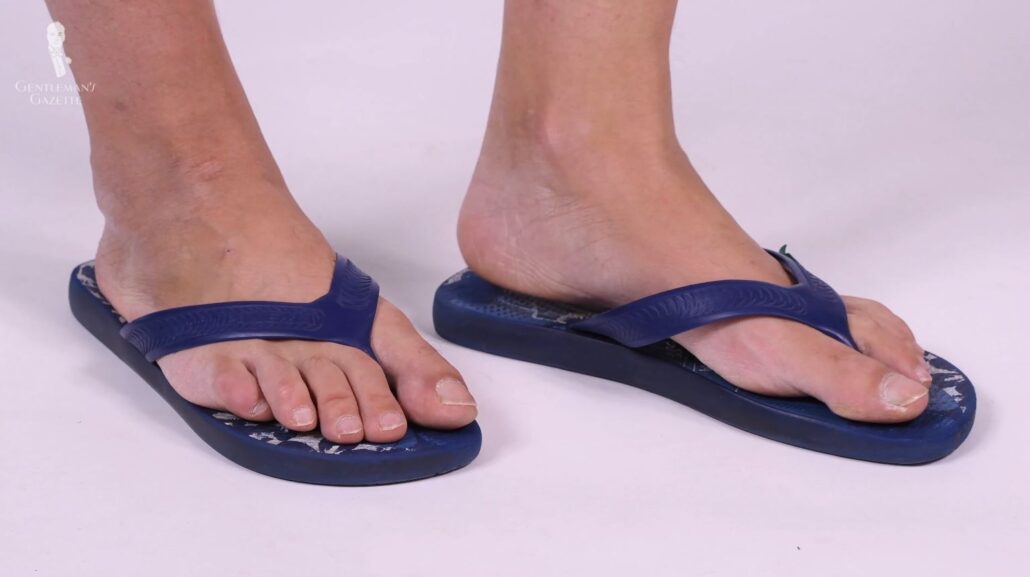
From personal experience, we haven’t quite found flip-flops to be comfortable for all-day wear, especially when compared to a well-made pair of dress shoes. For many people, the lack of support can lead to physical issues, but that hasn’t done much to shake the popular perception that the lightweight design and explosive ventilation of flip-flops, which allegedly mimics the experience of being barefoot, makes them that much more comfortable.
5. The Heroic Physique
Finally, we’ll offer one more explanation as to why men started wearing flip-flops that goes all the way back to the shoe’s origins. When flip-flops were first introduced, a beach bod craze saw young men desperately trying to achieve the muscled and chiseled physique of Charles Atlas.
And from the 2000s onwards, as the flip-flop rose to supremacy, the desire to emulate ripped reality TV stars, muscled musicians, and the latest heartthrob superheroes has only grown stronger. With more and more men invested in health-conscious living and regular sessions at the gym, flip-flops may be an extension of the desire to wear athleisure because it highlights your build, showing off the hard work you put into building the perfect body.
![Charles Bodybuilder Charles Atlas [Image Credit: Kamalani Hurley]](https://www.gentlemansgazette.com/wp-content/uploads/2022/07/charles-1030x604.jpg)
Like shorts or sleeveless shirts, the flip-flop puts more of the body onto display; perhaps explaining their popularity with young athletic celebrities. Perhaps in this sense, flip-flops are reminiscent of the ancient sandals worn by the gods and heroes immortalized in Marvel.
These social movements were helped by the fact that, as mentioned, these manufacturers marketed these flip-flops as everyday wear. So, between organic desire and a little prepackaged push, it’s not hard to see how flip-flops got such a strong foothold in menswear.
Is There A Place For Flip Flops In Classic Style?
The question then becomes: should you wear flip-flops as a part of an interest in classic style? We’re still going to have to agree with the assessment Raphael made in our “19 Things Men Should Never Wear” post.
19 Things Men Should Never Wear
When it comes to classic style, we do believe that flip-flops have a place. That place just happens to be at the beach or at the pool. If you’re cultivating a classic look, we feel there aren’t as many circumstances that will allow for flip-flops.
![Sean Sean Connery as James Bond in the 1965 film "Thunderball" wearing a pair of leather sandals [Image Credit: United Artists/MGM]](https://www.gentlemansgazette.com/wp-content/uploads/2022/07/sean-1030x578.jpg)
And if flip-flops just aren’t your thing, don’t fret. The classic style offers many alternatives that are beach-appropriate. You can find two of our favorites modeled by Sean Connery as James Bond in the 1965 film Thunderball. He wears a pair of simple leather sandals, which provides all the airiness of flip-flops, with a more secure fit and more classical lines, and also a pair of timeless espadrilles for a more formal, substantive look.
Conclusion
We hope that, in learning about the history of flip-flops, you better understand why men started wearing them and what the role is in relation to classic style. Personally, my favorite time to wear flip-flops is when I’m on a boat.
How do you like to wear your flip flops? Share your style insights in the comments!
Outfit Rundown
Today, I’m wearing a brown mule-skin jacket, a white and brown striped shirt, blue trousers, white leather sneakers, and brown Fort Belvedere socks. Check out the Fort Belvedere Shop for socks like these.
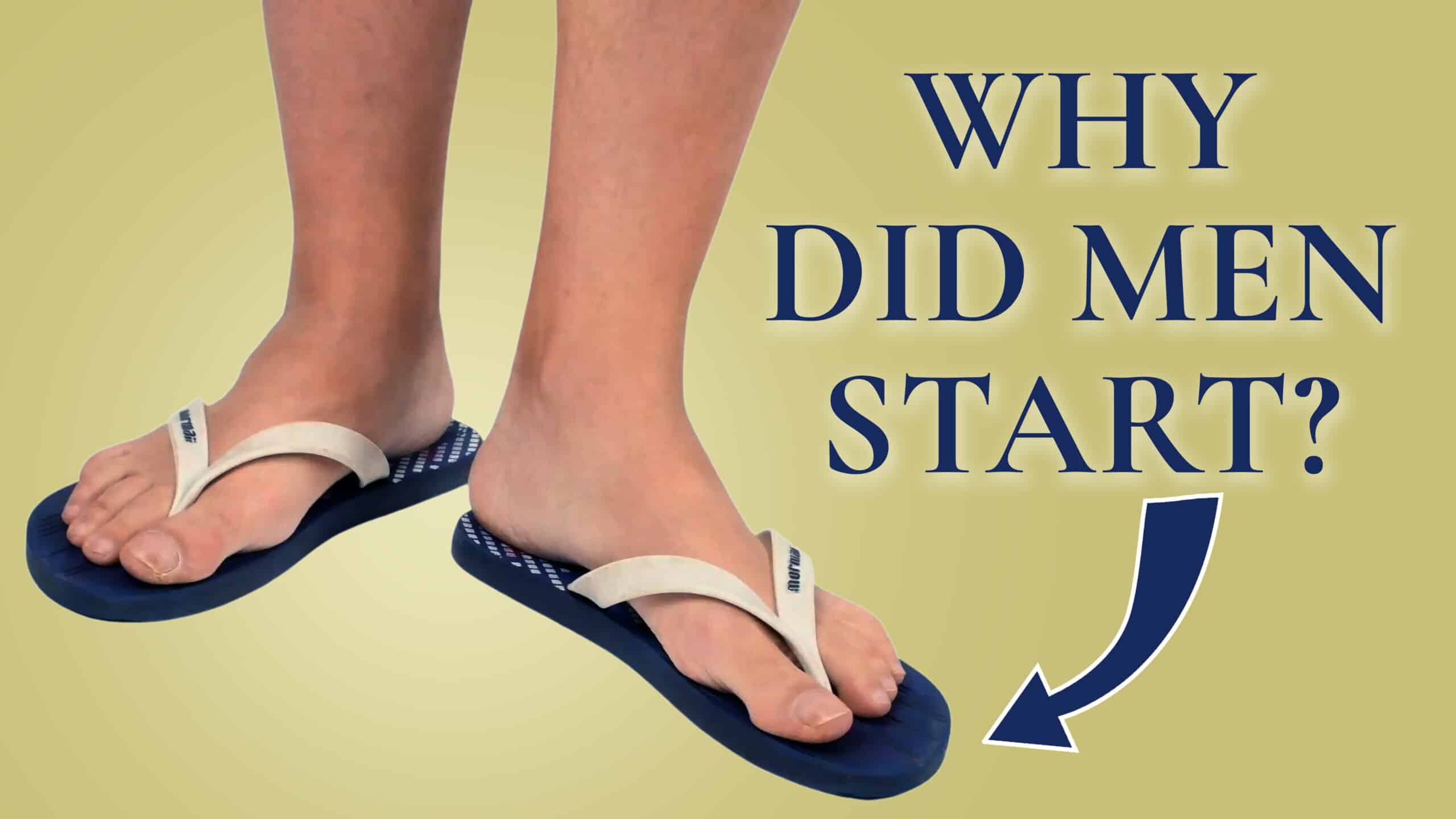

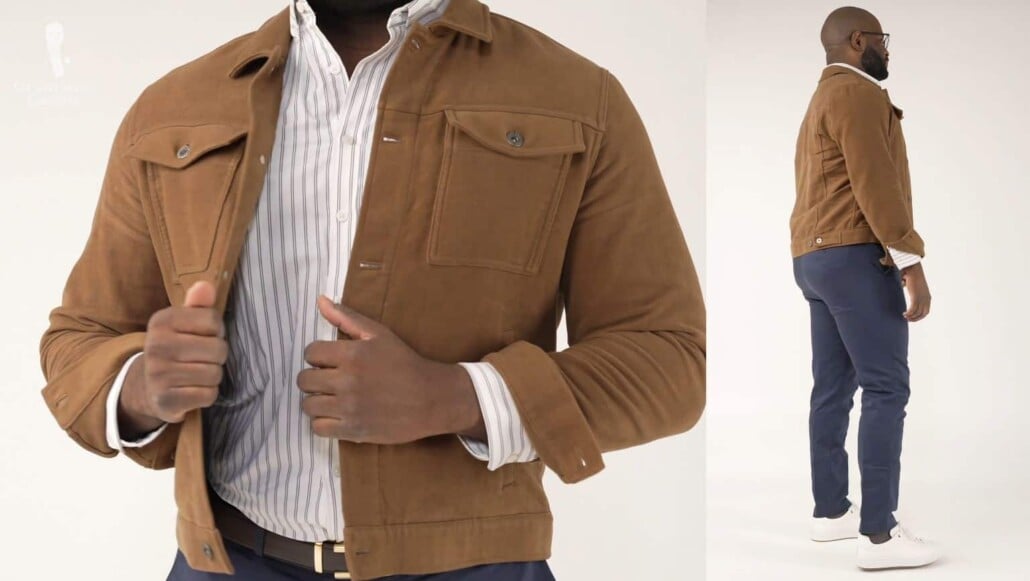
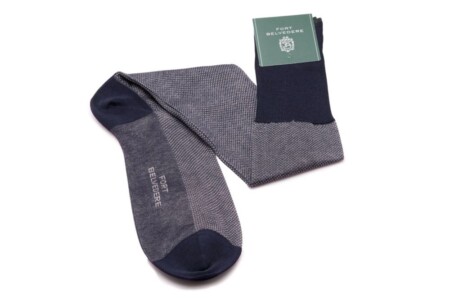
What else can one possibly wear in the shower?
Possibly Crocs but personally, I think flip flops are the most practical shower shoes. I don’t think anyone at GG is saying don’t wear flip flops at all so much as in the appropriate context like anything else. Case in point: white socks. Raphael has previously slammed white socks especially with black dress shoes yet white over the calf dress socks with white dress pants/slacks or with light coloured seersucker suits and white bucks? Appropriate. Similarly, flip flops at the pool or the beach or public showers? Appropriate.
When men became too cheap and lazy to wear anything classier. Some argue for living in sweatpants and t-shirts +/- hoodies on the basis they’re cheap, easy (to throw in the washing machine) and faster to put on than aforementioned classier options. Flip flops are the the sweatpants of footwear.
LOL, well said!
I really can’t wait for this deplorable trend of urban flip-flop wearing to run its course. Last thing I want when dining in a nice restaurant is a view of men’s gross feet.
Where I live, they won’t let you in the door if it’s a “nice restaurant “.
I need to move to your city, Carol! Come to think of it, I don’t want that view even at a McDonald’s.
Nowadays anything goes. I used to remember seeing restaurants stipulate no flip flops and a list of other prohibited items. The last 12 months, I’ve seen people at those same restaurants in all of those things and looking very disreputable. I have to wonder whether the pandemic has had a lot to do with letting things slide. Ie. It’s seen as better to let customers in looking disreputable to fill tables and get money than it is to not let them come at all.
The flip side to that is most reataurants won’t let you in if you are barefoot. The flip flop is the next closest thing, so just like any other socially-imposed convention (no bare feet) this is a way to scrape by and/or push the limit.
Outside of the beach, boat or bath, there is no appropriate place for men’s sandals.
If we’re talking proper leather sandals and worn with shorts for a casual occasion (think walking around town, barbecues, theme parks, etc) I can’t see the issue. Not to a nice restaurant or anything, though.
Great article.
I didn’t see any mention of medical considerations, ie – I’m a girl, and don’t know how common these things might be in men, but I have a connective tissue disorder that means I cannot construct my forefoot, which is highly compressible, I have a lot of blood pooling and edema, which necessitates some openness, adjustability, etc. Not to mention bad back, which also complicates footwear in general.
I do wear custom orthotics in my boots, can very seldom wear laced shoes….. but temperature changes and the wearing of dresses means I need sandals.
I do have a pair of Birks with a custom footbed ordered through a dr, but suede can cause friction in hot weather, and I can only imagine the general thought here for Birks.
But just saying…… I can’t imagine that no men have edema or joint issues that affect footwear options.
I’d love to hear how to deal with that and not look like a completely clinical person. I struggle with it ALL THE TIME. So am sure some men must as well?
And unless you’re lounging across a deck chair while someone else does the work, I don’t see how flip-flips are appropriate for a boat. ♀️
You raise an interesting point regarding l safety and flip flops – as the name suggests, they don’t offer a very secure hold!
I don’t know if it’s more painful to read about flip flops or see them plague our summer and warmer climate cultures. The point of their near useless utilitarian benefit (ok, hot sand or shower) leaves us with only the laziest among us in favor. I would be forever happy if I never saw another flip-flopped, camo-shorted, graphic T-ed, exposed butt crack human in public again. Sadly it’s almost a uniform in certain parts of Florida. Thanks for the article which inspires me to purchase another Fort Belvedere class item.
Hi Gerard, hopefully, the article turned out to be more enjoyable than you initially thought! ;)
We’re glad we were able to inspire you towards another Fort Belvedere item – what are you thinking of adding to your collection?
the only time men should wear sandals or flip flops should be on the beach!!
I guess people can do as they like (and they will, obviously), but I have never found the post jammed between the great toe and the one next to it to comfortable in any way.
Boat shoes like Top Siders, and Keds, for me, serve the same purpose. look a hell of a lot better, and are much more comfortable.
Another great video. While I love my Rainbow flip flops, I only wear them in the bathroom or on vacation at the beach or pool.
Unfortunately, it is sad to see men wearing them anywhere these days. I was having dinner with my wife just a few weeks ago at an upscale steakhouse and I couldn’t believe there was a guy there wearing flip flops. While I respect anyone’s decision to wear what they like, it is a travesty that an otherwise intelligent, professional man would want to dress this way in such an establishment. A lot of men (and women) just don’t seem to care about their appearance.
That’s fair enough – you’re wearing them in the appropriate situation. I don’t think even the likes of Raphael and Preston (the most formally dressed of GG staff) wear suits and dress shoes 24/7 and for all occasions.
You’re not wrong about most people (regardless of their sex) and being apathetic towards how they dress. I can remember being appalled when I went to university over ten years ago at the number of my fellow students who lived in boardshorts/cargo shorts (males; girls wore mostly daisy dukes or other little denim shorts), a t-shirt and flip flops or sweatpants in winter; the more formal ones wore jeans and sneakers (females tended more towards Ugg boots) but even then mostly faded light blue jeans rather than dressier indigo or black. As much as students (including myself) didn’t have much money and the unspoken dress code was casual, there’s casual and then there’s casual. I personally found students presenting in classes while dressed cargos/sweatpants and flip flops, especially if they were taking on the persona of a particular person or professional role, diluted their credibility as presenters and I struggled to take them seriously.
I thought men start wearing flip flops once convicted of a felony.
We live in a society where the least possible effort is everyone’s goal. Flip flops, sweats, baggy tshirts, etc. A few years ago I noticed 4-5 different men in a high-end steakhouse (all at different tables, dining with company) wearing T-shirts, flip flops, cargo shorts and ball caps. It was literally the most casual one could dress other than pajamas. The manager told us that diners become furious if the restaurant tries to enforce a dress code, regardless of day of the week or event. He stated that diners have told him “I can afford to eat here, so how I dress is nobody’s business!” What a shame for the people who saved for weeks to celebrate a special event, only to be sitting next to people more appropriately dressed for McDonalds.
Our Father taught us “When in Rome, do as the Romans do”, advice that taught us to respect the environment and culture of where you are. Flip flops are for the beach, pool or shower. We can all do better.
You’re not wrong there. I’ve even heard some of my fellow men declare proudly how they haven’t worn a tie, how they haven’t worn a suit, etc in XYZ years. Dressing up seems to = jeans, a hoodie and enclosed shoes. I think the pandemic has further compounded the attitudes of people like the ones you describe above who are self entitled to think that their presence and the fact that they’re spending money at a venue suffices. Even at weddings the culture seems to be that wearing dress pants and a collared shirt suffices with any jacket ditched the second one sits down. Very disappointing to see this growing culture of toning down the overall formality at all events and venues.
Agreed 100%. True story: one middle-aged man turned up to my father’s funeral earlier this year in a stained t-shirt, shorts, and running shoes. Slovenliness is so prevalent nowadays that we can’t really follow the “When in Rome …” principle anymore, as that would require us to dress like the inappropriately casual masses.
On a more optimistic note, if we continue to fly the flag for classic style when out in public, at least we are showing another option to men who may not have put much thought into what they wear. At a recent restaurant dinner, I overheard four young men at a nearby table grumbling about being neglected in contrast to the attentive service being paid to “that couple over there” (my wife and I). Then one of them said, “But then, of course …” and finished his thought with a wordless wave of the hand pointing to my suit and tie. Perhaps seeing the benefits of dressing for the occasion could inspire even a tiny fraction of men to dress up a bit more, which would be a win not only for those of us who already care, but also for them and their partners.
All men and a great number of women have ugly feet. What’s with this compulsion to display them for all to see.
“All men have ugly feet….” why the blanket statement? Speak for yourself Francisco.
I find them uncomfortable and rather vulgar. I emigrated to Australia twenty five years ago and was horrified to find them the footwear of choice for the majority, certainly for at least six months of the year. The only thing worse was the amount of people who walk around with no footwear at all! Nauseatingly a large number of wearers tend not to look after their feet particularly well and it pays not to lower ones gaze to ground level.
A well written article.
Thank you.
Thanks, Steve, glad to hear you enjoyed it! :)
I would never wear flip-flops or sliders for general use, Over the toe sandals, however. I view as equally acceptable as sneakers. The sock-less loafer look, seems a bit like trying to be one of the “cool” kids to me. Just my particular feelings. As Grandma used to tell me “Everyone likes something different. That’s why there are different flavors of ice cream.”
A wonderful quote from your Grandma, Greg – and very apt indeed!
I’m pleased you mentioned the term “Jandals” because in New Zealand we call them that, not flip-flops. A huge advantage of them for casual dress in summer is that they are cooler than any other footwear (including boat shoes). They are very easy to slip on and off, not requiring hands to do so.
Different countries have different names for them. NZ say jandals, Australia calls them thongs (years ago, Heath Ledger horrified Americans by talking about he and his mates wear their thongs down the street. I had to smile) and in the USA they’re flip flops. Either way, there’s still more stylish footwear one can wear to keep their feet cool (leather sandals) or if they’re wanting something to slip on. Eg. Espadrilles, loafers, moccasins, etc. Outside the beach or pool or maybe medical reasons (eg. Having surgery on feet or toes and being unable to wear shoes) flip flops or thongs make one look sloppy and underdressed.
Another reason: men started wearing flip flops because their women were already. It fits with the ready-for-anything vibe that young guys who want to be around women like to cultivate. Women from some Asian cultures go barefoot in their homes and it’s polite to do the same. Do you really want to be sitting there pulling off socks and untying laces when you first get in the door?
Going barefoot can lead to many health benefits from improved posture amongst other reasons, and historically has been shown to enhance athletic performance as evidenced by the techniques of Percy Cerruty, one of whose athletes- Herb Elliot, won the 1960 Olympic 1500m final by a record margin.
Each foot has twenty-eight bones and nineteen muscles that function better when unfettered by a shoe- bespoke or otherwise, sandal, or flip flop. If it is safe to walk barefoot, give your feet a chance other than when you go to bed or take a bath.
I’m not disputing that but like everything else, there’s a time and place for going barefoot and/or wearing flip flops. When I’m at home after a day at work (except when it’s freezing cold) then I prefer to go barefoot at least indoors. Yet if I’m expecting guests then I’ll wear proper socks and shoes.